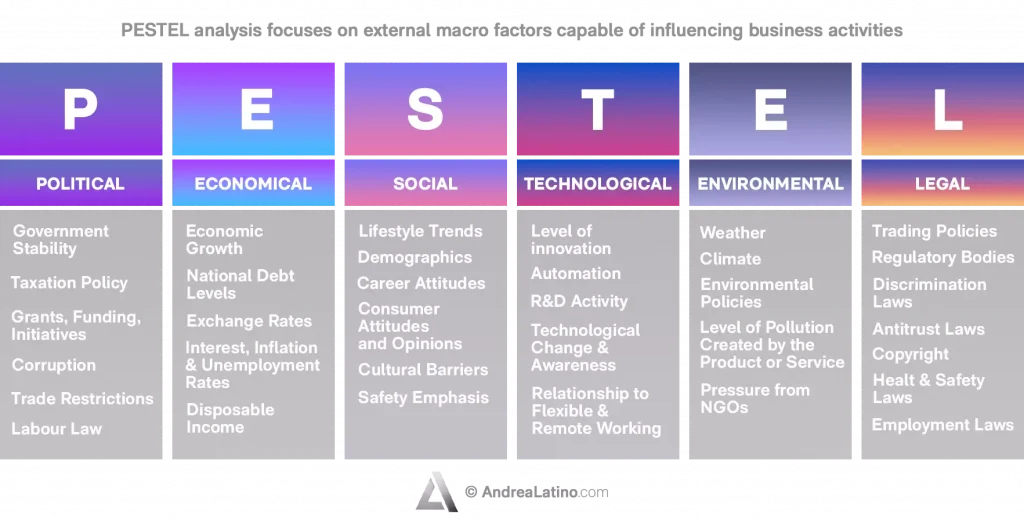Innovation Alphabet
PESTEL Analysis
in a nutshell
PESTEL analysis is a popular strategic planning tool that focuses on external macro factors capable of influencing business activities. The acronym considers six factors: Political, Economical, Social, Technological, Environmental and Legal.


Application Fields

• Product development: By monitoring the external environment, a PESTEL Analysis can first help a company determine whether or not it makes sense to enter a given market. Also, it helps to understand whether a product or service meets a need of potential customers, or the best time to launch a new product proposition.
• Marketing: A PESTEL Analysis also draws on the external situation during the planning phase of marketing strategy. It can help a business consider the most striking current national or international events and build around them a coherent initiative with broad themes of generalized interest.
• Business strategy organization: Analysis also helps to gain an in-depth understanding of the context within which strategic change may (or may not) occur. It is even more effective when used in conjunction with a SWOT analysis to understand opportunities and threats that may arise, such as legislative or environmental issues.
Do you have a Public Affairs & Comms challenge to tackle? Let’s face it. Together.
C-levels from these companies (AND MORE) relied on my expertise to overcome thEIR CHALLENGES IN THIS AREA. And You can, too.
Can I help you?Industries
• PESTEL Analysis in the FMCG industry
PepsiCo is a famous American multinational food, snack and especially beverage company. The soft drink rival of Coca Cola, at least in the American market, is regulated by the Food and Drug Administration (FDA). It has to comply with a number of parameters, standards and current production laws, not to mention the existence of laws in international markets that regulate trade. In short, there are obvious legal implications to consider.
• PESTEL Analysts in shared mobility
Uber is an exemplary business model that applies the sharing economy to mobility. Among the external factors that the company needs to keep well in mind is, once again, the legal one: for example, the service arrived in Italy in 2013, and four years later it had to clash with the taxi drivers’ trade association, which decided to sue the Silicon Valley company for a competition deemed unfair.
• PESTEL Analysis in sports products
In the production of apparel and sporting goods, Adidas is second only to American rival Nike in the same market. The challenge lies in being able to read social factors, to keep up not only in terms of the performativity of garments, but also by proving to go along with the current trends. Athleisure, for example, is a trend that consists of wearing garments originally designed for sports activities in casual settings. But Adidas also competes with other factors, such as technology – think, for example, about tracking in running shoes – and the environment.
Business functions
• PESTEL Analysis in support of the manufacturing industry
As we know well, Apple offers a plethora of electronic devices and services. The manufacturing industry, however, must get approval from several external factors, such as economic, which determine the cost of labor and thus the product. But also, legal: if Apple decides to manufacture cars, it would first have to confront the associated regulatory costs and go through prolonged bureaucratic processes.
• PESTEL Analysis in support of communication
The Japanese multinational Sony Corporation trades in electronic products: video games, consoles, televisions, as well as movies and music. In short, it produces a 360-degree form of entertainment. Thus, the technological factor is of primary importance to the brand, even though it may clash with economic and social aspects (think of the typically adolescent video game addiction).
• PESTEL Analysis in support of investment management
Instagram is among the most widely used social networks in the world: it has, on average, 500 million daily active users. In 2012, however, it still had (relatively) very few. That is why when Facebook decided to buy it many people turned up their noses. Yet within just a year, its value grew by leaps and bounds. Most of the revenue came from paid ads, which saw a 177 percent increase in 2018. Mark Zuckerberg understood that proper analysis of external economic factors gives a better understanding of which areas to invest in.
Stay in wonderland
Let me show you how deep the rabbit hole goes.
Check out more of the Innovation Alphabet:

3D Printing
3D Printing
“3D printing” is a process carried out by an electronic device which, instead of resorting to the canonical ink, it molds almost any kind of material: from concrete to living tissue, most usually plastic, but also metal. And the operating principle is similar to that of a traditional printer. The creation of three-dimensional models can lead to the redesign of a company’s production capabilities.
Dive In
5G
5G
5G is the new frontier of cellular telephony. It was designed to improve (or completely replace) previous generations of mobile networks. The 5th generation features lower latency, ensuring flawless performance of business applications and many other digital experiences – thus enabling the new cultural generations to furiously play Fortnite away from home.
Dive In
Advanced Analytics
Advanced Analytics
The term “Advanced Analytics” refers to the ability to autonomously or semi-autonomously analyze data and content to identify correlations, develop analyses, predictions, and recommendations. It is not just a matter of collecting information and then organizing it into watertight compartments: the ultimate goal is to identify a dialogue pattern from a data-driven perspective.
Dive In
Agile
Agile
Agile is an approach to software development designed to respond to change. Teams quickly analyze the context in which they operate, identify uncertainties faced, and figure out how to adapt to always move forward. Interaction between individuals comes before processes and tools; collaboration with the customer is more important than negotiating contracts.
Dive In
Ansoff Matrix
Ansoff Matrix
The Ansoff Matrix is a marketing planning model that arises from the intersection of new and existing products and markets. It derives four possible strategies for expanding the company’s market, which are built around four variables with a changeable factor of risks and possibilities: existing product, new product, existing market, new market.
Dive In
Artificial Intelligence
Artificial Intelligence
Artificial Intelligence is not strictly defined. Basically, it is a computer system able to make decisions in an independent and flexible way. A good AI application can perform everyday tasks better than an average person (e.g., identifying other people from their photos on social media or beating the best chess player). Nothing to fear, then. Unless you are a chess champion.
Dive In
Artificial Scarcity
Artificial Scarcity
We often tend to desire what we cannot have. Or what we are in danger of losing: Artificial Scarcity is a strategy that flaunts a limited number of items that do not correspond to actual availability. The goal is to stimulate the perception in consumers that the stock of items is about to run out and thus create a need based on the “fear of being cut off” or the intention to buy the item in order to resell it at a higher price.
Dive In
Attack Surface
Attack Surface
The term attack surface refers to the part of a system that may be subject to attack or breach by hackers. The smaller that surface is, the easier it will be to protect it. Indeed, the Internet is an ocean of deep, dark waters: those who navigate it must be aware that they are exposing themselves to a flood of digital risks. Yet, ironically, we do not need a big boat to shelter us.
Dive In
Augmented Reality
Augmented Reality
Augmented Reality is an ever-evolving technology that overlays multimedia information on top of our common sensory horizon to gain a deeper understanding of our surroundings. No, it doesn’t allow you to step out of the Matrix dream simulation, nor can it be accessed by swallowing a red pill. But neither is it the disturbing experience of the Playtest episode of Black Mirror.
Dive In
Balanced Scorecard
Balanced Scorecard
In business, as in life, you need balance. The Balanced Scorecard is a holistic tool for strategic management. It offers, in fact, the possibility of assessing corporate performance in its wholeness. An overview that embraces four perspectives: the business/financial side, customers and stakeholders, internal processes, and learning and growth.
Dive In